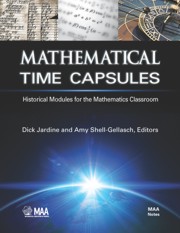Book contents
- Frontmatter
- Preface
- Contents
- 1 The Sources of Algebra
- 2 How to Measure the Earth
- 3 Numerical solution of equations
- 4 Completing the Square through the Millennia
- 5 Adapting the Medieval “Rule of Double False Position” to the Modern Classroom
- 6 Complex Numbers, Cubic Equations, and Sixteenth-Century Italy
- 7 Shearing with Euclid
- 8 The Mathematics of Measuring Time
- 9 Clear Sailing with Trigonometry
- 10 Copernican Trigonometry
- 11 Cusps: Horns and Beaks
- 12 The Latitude of Forms, Area, and Velocity
- 13 Descartes' Approach to Tangents
- 14 Integration à la Fermat
- 15 Sharing the Fun: Student Presentations
- 16 Digging up History on the Internet: Discovery Worksheets
- 17 Newton vs. Leibniz in One Hour!
- 18 Connections between Newton, Leibniz, and Calculus I
- 19 A Different Sort of Calculus Debate
- 20 A ‘Symbolic’ History of the Derivative
- 21 Leibniz's Calculus (Real Retro Calc.)
- 22 An “Impossible” Problem, Courtesy of Leonhard Euler
- 23 Multiple Representations of Functions in the History of Mathematics
- 24 The Unity of all Science: Karl Pearson, the Mean and the Standard Deviation
- 25 Finding the Greatest Common Divisor
- 26 Two-Way Numbers and an Alternate Technique for Multiplying Two Numbers
- 27 The Origins of Integrating Factors
- 28 Euler's Method in Euler's Words
- 29 Newton's Differential Equation ẏ/ẋ = 1 − 3x + y + xx + xy
- 30 Roots, Rocks, and Newton-Raphson Algorithms for Approximating √2 3000 Years Apart
- 31 Plimpton 322: The Pythagorean Theorem, More than a Thousand Years before Pythagoras
- 32 Thomas Harriot's Pythagorean Triples: Could He List Them All?
- 33 Amo, Amas, Amat! What's the sum of that?
- 34 The Harmonic Series: A Primer
- 35 Learning to Move with Dedekind
- About the Editors
7 - Shearing with Euclid
- Frontmatter
- Preface
- Contents
- 1 The Sources of Algebra
- 2 How to Measure the Earth
- 3 Numerical solution of equations
- 4 Completing the Square through the Millennia
- 5 Adapting the Medieval “Rule of Double False Position” to the Modern Classroom
- 6 Complex Numbers, Cubic Equations, and Sixteenth-Century Italy
- 7 Shearing with Euclid
- 8 The Mathematics of Measuring Time
- 9 Clear Sailing with Trigonometry
- 10 Copernican Trigonometry
- 11 Cusps: Horns and Beaks
- 12 The Latitude of Forms, Area, and Velocity
- 13 Descartes' Approach to Tangents
- 14 Integration à la Fermat
- 15 Sharing the Fun: Student Presentations
- 16 Digging up History on the Internet: Discovery Worksheets
- 17 Newton vs. Leibniz in One Hour!
- 18 Connections between Newton, Leibniz, and Calculus I
- 19 A Different Sort of Calculus Debate
- 20 A ‘Symbolic’ History of the Derivative
- 21 Leibniz's Calculus (Real Retro Calc.)
- 22 An “Impossible” Problem, Courtesy of Leonhard Euler
- 23 Multiple Representations of Functions in the History of Mathematics
- 24 The Unity of all Science: Karl Pearson, the Mean and the Standard Deviation
- 25 Finding the Greatest Common Divisor
- 26 Two-Way Numbers and an Alternate Technique for Multiplying Two Numbers
- 27 The Origins of Integrating Factors
- 28 Euler's Method in Euler's Words
- 29 Newton's Differential Equation ẏ/ẋ = 1 − 3x + y + xx + xy
- 30 Roots, Rocks, and Newton-Raphson Algorithms for Approximating √2 3000 Years Apart
- 31 Plimpton 322: The Pythagorean Theorem, More than a Thousand Years before Pythagoras
- 32 Thomas Harriot's Pythagorean Triples: Could He List Them All?
- 33 Amo, Amas, Amat! What's the sum of that?
- 34 The Harmonic Series: A Primer
- 35 Learning to Move with Dedekind
- About the Editors
Summary
Introduction
The Pythagorean Theorem is one of those intriguing geometric concepts that provide a never-ending source of ideas at all levels. Proofs of this theorem abound in print, and one wonders whether humans will ever stop looking for yet another. Indeed, it would be unusual for a student who has taken algebra or geometry not to have been exposed to at least one proof of the theorem, but how many have had occasion to explore the proof appearing in Euclid's Elements? In this proof, Euclid introduces a clever and elegant application of the concept of shearing. It is a proof that provides a golden opportunity not only to bring some history into the classroom, but that also provides us a natural venue to highlight connections between algebraic and geometric concepts. Moreover, the proof presented by Euclid has the useful property that it provides for generalizations of the theorem in a number of different directions. For example, by using shearing one may prove Pappus' theorem, which is a Pythagorean-like theorem for arbitrary triangles. The concept of shearing itself can then be generalized in the form of Cavalieri's principle to determine the volume of more general solids.
In Book XII, Euclid again applies a technique that is connected to the concept of shearing, this time in three dimensions. The problem is seemingly unrelated: determining the relationship between the volumes of pyramids and prisms that share the same base and height. This application provides contemporary teachers an opportunity to motivate and illuminate the ostensibly nonintuitive formula for the volume of a pyramid.
Information
- Type
- Chapter
- Information
- Mathematical Time CapsulesHistorical Modules for the Mathematics Classroom, pp. 45 - 54Publisher: Mathematical Association of AmericaPrint publication year: 2011
